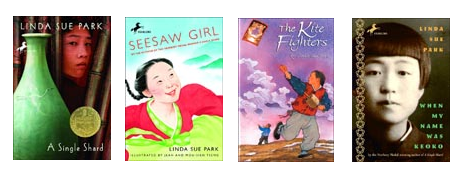
My kids and I are huge fans of award-winning writer, Linda Sue Park. Her book, A Single Shard, is one of our favourites. It is a vividly told tale set in Ch’ul’po, a potter’s village, in 12th-century Korea. The protagonist is 10-year-old orphan, named for a mushroom that grows “without benefit of parent-seed”. He was raised by Crane-man (he has a shrivelled leg). These two outcasts make their home under the bridge and scavenge for food, refusing to beg or steal. When he accidentally breaks a pot belonging to Min, a master potter, he has to work off his debt and this sets off a series of change. I won’t say more except that if you like a story about loyalty, courage and love, then this is the book for you.
My friend at Tea and A Think is a fellow fan of the book :) She has compiled a wonderful list of facts on Korea and links to celadon pottery and Korean food. You can do a great unit study based on these links and her other book recommendations.
We’ve also enjoyed Linda Sue Park’s other books. I strongly believe in using living books and hers are wonderful for History and Geography. See Saw Girl tells of Jade, a girl of good social standing in 17th-century Korea who longs to see the world. Women then did not leave home (LITERALLY) till they married and then, did not ever step outside the walls of their marriage home. The Kite Fighters is about two brothers Kee-Sup and Young-Sup in 15th-century Korea. Young-Sup, the younger, often feels envious of his older brother, who seems to be favoured simply because he is the first-born. When the young king enlists their help for a kite competition, they learn to complement each other and understand each other better.
When My Name Was Keoko takes us to a more contemporary time – 1940 to the end of the second World War. Korea has been occupied by the Japanese since 1910 and their oppressive rulers are determined to erase the Korean identity and culture through propoganda and outright force. We see the struggle of the Korean people through Sun-hee (who is forced to take on the Japanese name Keoko) and her brother Tae-yul who narrate the story in turns. Each of the characters we meet show courage in their own unique way. We learn not just about role of Japan in WW2 but also what happens to Korea after it regains its independence. What makes this story even more meaningful is that the characters were inspired by true stories told by the author’s friends and family.
Korean paper doll – lots more paperdolls from all over the world available for download at Education.Com


Asalamualaikum,
Your blog was one of the first I read when I first started thinking about homeschooling a few years back.
I am also very interested in Charlotte Mason’s approach and if you don’t mind me asking. How do you plan, (if you do) the books that you will study. Do you just go with whatever topic that is sparking interest?
JazzakhAllah.
wa `alaykum as salaam wa rahmatullaahi wa barakaatuh
Dear UmSaara
Jazakillah khayran for dropping in :) I fell into the CM method even before I knew what it was to be honest. I’ve always loved books so I made it a point to have a lot of good literature for my kids and to read with them for a good part of the day. Yes, I do some planning about the books if they are related to their curricula. We try to use BOTH text books and living books and not just use text books alone.
When I am in Singapore, I do a little bit of planning as to what we will read. If the kids are interested in a particular topic be it Science/Geography/History or anything else that they like outside the curriculum, I do a bit of research on the books I can borrow from the library/buy. I check out Penny Gardner’s Site and book review sites (you can see these links on the All About Books Section on my blog). Simply Charlotte Mason also has a bookfinder.
When I am in Pakistan though, I don’t plan as much. There aren’t any libraries and I avoid online shopping due to the high shipping costs. I just buy lots and lots of books every chance I get when we hit the second-hand bookstores and work from there.
How old are your kids? Would they be interested in my daughter’s goodreads? (It hasn’t been updated in ages but there are some 500 books listed!)